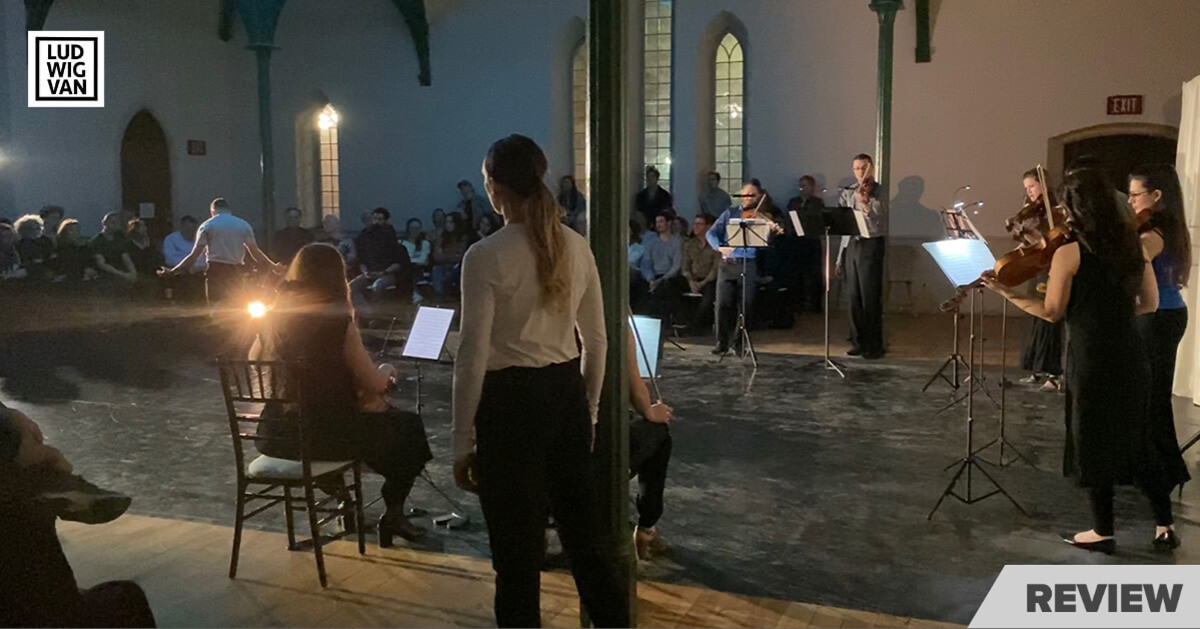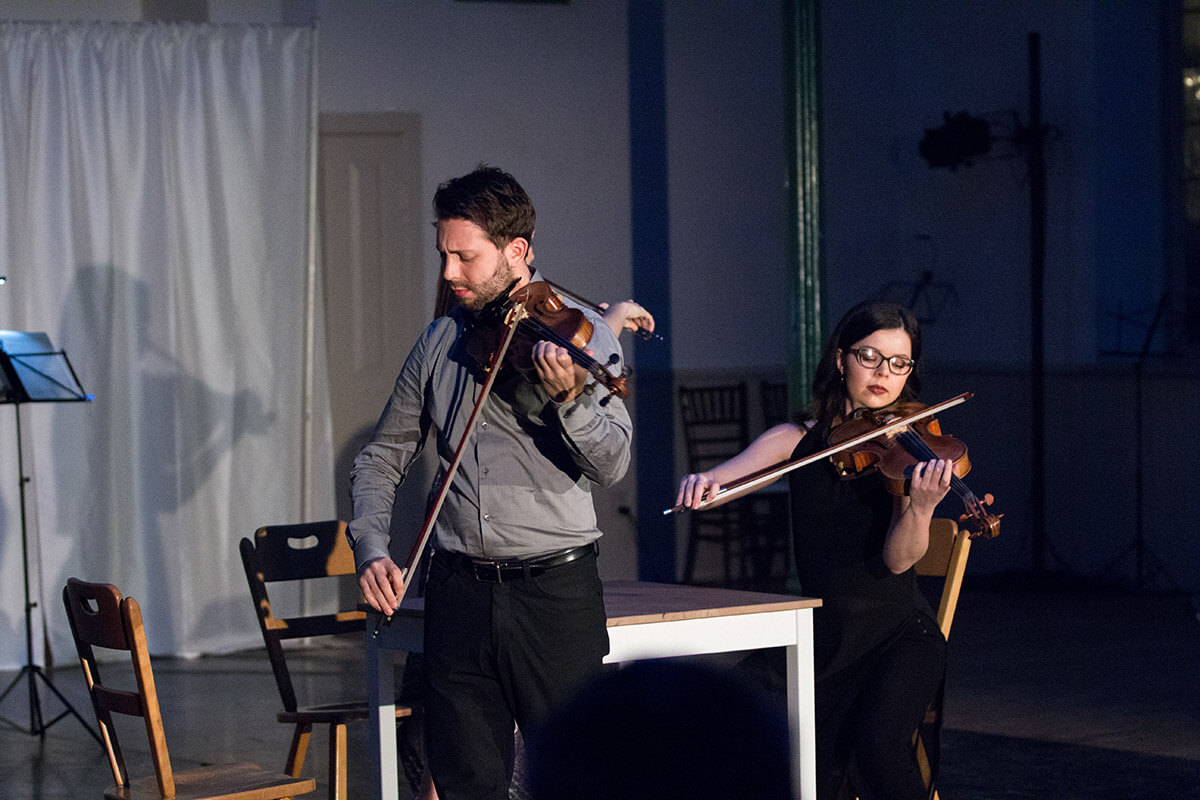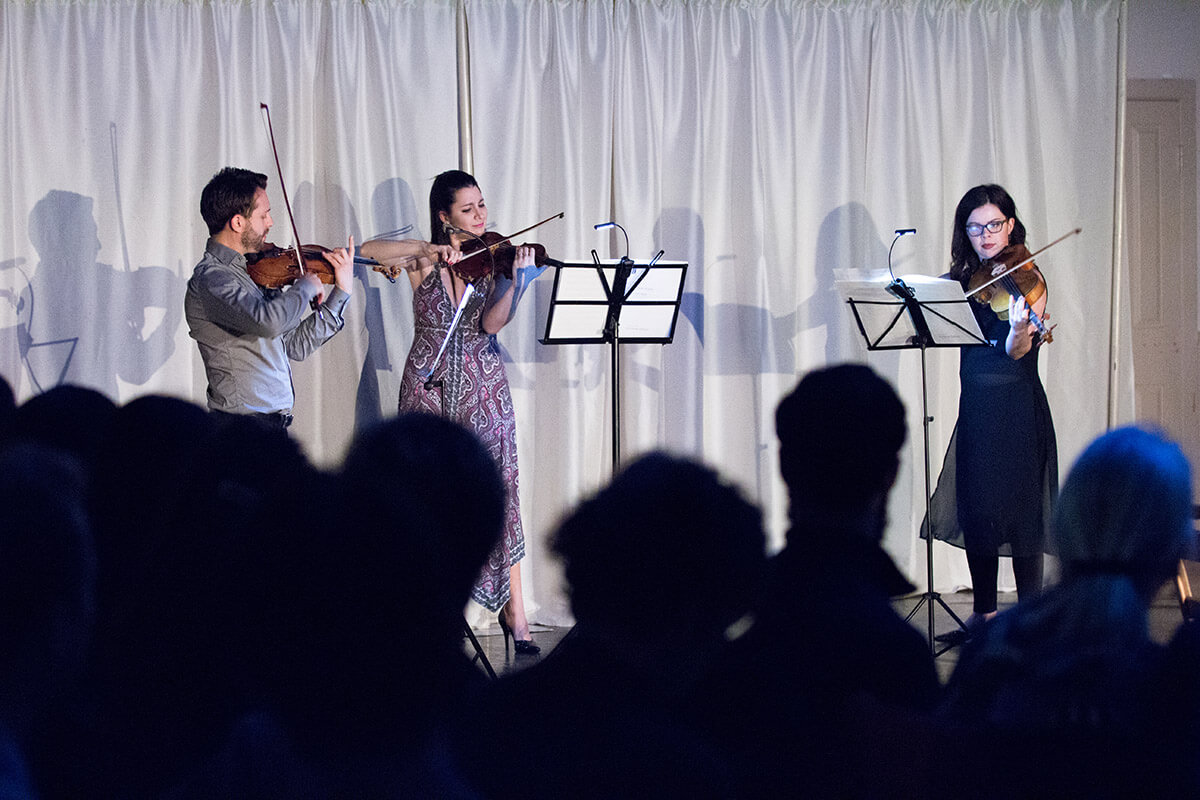
Echo Chamber Toronto: John Corigliano’s The Red Violin Caprices, Zoltan Kodály’s Serenade for Two Violins and Viola and Enescu’s Octet opus 7. Aaron Schwebel; violin and artistic director. Choreography by Brendan Saye and Hanna Kiel. Musicians: Aaron Schwebel, Jamie Kruspe, Emily Kruspe, Csaba Koczo, Sheila Jaffe, Catherine Gray, Leana Rutt, Carmen Bruno. Dancers: Ryan Lee, Kelly Shaw, Hannah Galway, Donald Thom, and Naoya Ebe. Choreography: Brendan Saye and Hanna Kiel. At the Enoch Turner Schoolhouse. Feb. 23, 2020.
When you go to an Echo Chamber Toronto recital, you can bet you will come away excited, refreshed, and pondering the future of music in our century. Or, at least you will want to reconsider whether we ought to continue performing music as it has always been presented, as a static object brought to abstract sonic life, and nothing more.
And then wouldn’t you wonder if it were time everything we presented in the music world ought to be co-produced with dance, light and the visual arts, just as Echo Chamber Toronto has accomplished so convincingly? Well….perhaps not everything, but certainly many for us are ready for the twenty-first century to collaboratively re-imagine most pieces of music we take for granted. Surely it is time to enliven music with more of the arts in an era that is ready for such enterprising approaches to collectivized art. Why should it be restricted to opera (i.e, Against the Grain Theatre).
Echo Chamber is Toronto’s hottest chamber performance series going these days. Over the weekend, founder and artistic director Aaron Schwebel’s futuristic and visionary troupe presented another tribute to the literary modernist era of a century ago with even greater success than the ensemble’s previous instalments.
The friendly confines of the Enoch Turner Schoolhouse Museum behind Little Trinity Church off King St. E. were lit up splendidly last night, whether in light, sound or movement, with a gypsy-themed program titled Zingara, featuring clashes of Klezmer with Kodály and sultry Corigliano with early sweet, but still-classic Enescu.
With Marley floor brought in specially for the dance performances the acoustic became transformative space, flanked on three sides by four rows of chairs, nearly all of which were occupied for both performances of Enescu’s Octet, Kodály’s Serenade for Two Violins and Viola and a brilliant lead-off virtuoso performance by Sheila Jaffé of Corigliano’s The Red Violin Caprices.
The dance was not distinctively gypsied in any manner, but there was a sense throughout the programmatic choreographies that the scenarios were about friendship’s youthful freedom veering into fraught relationships over a lifetime. In the first half, The National Ballet’s Brendon Saye impressed with a thoughtful choreography about three friends and their explored intimacies gained, lost and regained, while the second half included some brilliant collaborative work by Hanna Kiel that was remarkable for its suitability in matching structure, form and colour to the thickly textured Octet. It was often emotionally engaging and even aesthetically overwhelming in the most positive sense — a beautiful series of dance performances all around.
But the Zingara mood required the right start and that meant unerring thick tone and atmospheric sparkle from a violin that could sound like twice its size and volume. Sheila Jaffé fit the bill perfectly for this: she was on target with the mood from the very start. With equal verve, dancer Hannah Galway entered, sat at a table reserved for friends perhaps for some drinks and social good times, but quickly presses the table as though remembering something very unhappy. But, mostly Galway was on stage to use her supple frame to match musical aesthetic with lithely quasi-improvised, whole-body work. She was spellbinding and beautiful.
Joining her soon after and continuing the narrative arc throughout the entire first half (including the Kodály Serenade) were Donald Thom and Naoye Ebe, depicting her two friends (all are with The National Ballet) in some beautiful partnering. What ensued was a fairly taut yet poetic series of study caprices in solo line and spatial imaginativeness. Galway’s gracious and fluidic movement adapted well to Corigliano’s double-stopped bravura violin variation, all supplied with Jaffé’s ferocious performative power, filled with complementary thick tone, full of stride and swagger, blending her bowing motion with Galway’s dancing motion.

What a contrast that was to the intimacies which followed when the three dancers continued the story throughout the Kodály Serenade. If it was tone that did the talking throughout, it certainly gave the dancers all they needed for a trio of intimacies, difficult quick lifts and a few momentary supports to tell their story of friendnsip, love and loss, the signature theme of the essential gypsy spirit behind much of this music’s spritely folk rhythms and unpredictable tempo changes.
Transitioning into the Serenade, Aaron Schwebel played some glorious, smoky-timbred klezmer — utterly seamless and beautifully tuned. It should be said that here as throughout, Schwebel has a remarkable ear, capable of adapting different intonation systems as he shifts repertoires while adjusting tunings as needed, and often was the very soul of gypsy violin music itself. Listening to him is like watching magic — you know what he’s doing, you appreciate it at its deepest level of refinement, but you still can’t see how it’s done even though it is happening right before your eyes.
The ensemble came together in the “Lento, ma non troppo” slow movement. Catherine Gray’s viola solo over Jaffés second violin tremolo line was glorious. Again, tone was everything, and Gray is an immense talent. Watch for her: she is the ideal soloist and a chamber performer of superb musicianship and high quality. Schwebel’s dialogue with Gray’s burnished tone on viola was a sonic highlight of the night, only to be one-upped by the last movement of the Enescu Octet.
And somewhere in all that, Sheila Jaffé kept playing with a smile because unbeknownst to the audience, she had broken the E string on her violin. She played the entire third movement by adapting her shifting on the fly and kept on adjusting much of her fingering through that killer finale of driving folk-dance rhythms as though nothing had gone wrong. It was an unbelievable display navigating that relentlessly beautiful Hungarian folk music, which Kodaly loved to adapt into his compositions throughout his career.
The trio was electric and the dancing only made it all the better. But perhaps the secret story was Jaffé conjuring up the spirits of those Gypsy violinists, who often had to play on broken or damaged instruments — Jaffé, for those focused moments in time, embodied their entire esprit de corps and was “Zingara” herself. I will not soon forget it.
And that was the first half. I could hardly wait for the second half’s Enescu Octet, a young work by a very young eighteen-year-old composer intent on testing his mettle in a genre few could master. Mendelssohn wrote his Octet about the same time in his life (he was sixteen), and Enescu intended to not only prove he could do the same but also write it in the more difficult cyclic form, where the entire sonata structure is extended out over all four movements.
However glorious the performance was — and it was never anything less than that for a second — the brilliance that enhanced the entire experience was found in Hanna Kiel’s collaborative choreography.

Kiel’s is an established contemporary choreographic voice with deep experience in layering her narratives carefully and judiciously. First, she brings her audience into a gradual awareness of emerging storyline and developing relationships, gradually building the narrative until it finally enfolds the viewer inside an emotionally complex texture. Kiel effectively layered Enescu’s third movement with a conversational duet that turns into a disagreement but resolves into a three-part texture of reconciliation in the final movement.
The magic is found not only in the opening gestures soon transformed into broader strokes of gracious curvatures, but in the sensuous conversations and verbal movement intimacies layered delicately one on top of the other, a mirror to the textures of the Octet’s sonic structures itself. Even the dancers imitated each other in this manner in gesture and broad motion while the string counterpoint tossed developmental motives back and forth in slow, sobbing shadows. The duo of Hannah Galway and Ryan Lee (Lee was my favourite dancer, and this was my favourite partnering of the evening), entering in the third movement, seemed to crescendo with the musical cues into a tragic separation. Then Galway took an athletic solo to a lovely series of eight counts, flexing lithely, in supported penchés one moment, and some convincing floor work the next, painting the Octet’s throbbing slow movement in darkest enamelled hues. But it was the final movement’s contrapuntal shadow play and shimmering ghostliness that found dance and music interacting at their utmost. While the eight players divide into three sections — the second quartet plays in muscular octaves while the first quartet divides into a full-on quasi-embellished solo in first violin (another masterful moment for ensemble director Aaron Schwebel) as the other three performers are in pizzicato — the three dancers (now including Kelly Shaw) imitate this eclectic three-part texture as three seemingly independent body types, taking these irreconcilable elements of a musical-movement texture and making their bodies elide to its contours as smooth as glass.
Dance becomes music as music becomes dance.
And that is what Echo Chamber is about — bringing the arts together to show how our minds and hearts work when we are enticed into such a combined experience, just as the literary, musical and artistic modernists had wanted it to be over a century ago.
It has taken until now for the movement to re-appear and for it to gain such popular traction with the Toronto music and dance public that we can only hope Echo Chamber will continue for years to come as the premier exponent of how performance art, in all its possible multiple manifestations, ought to be presented.
#LUDWIGVAN
Want more updates on classical music and opera news and reviews? Follow us on Facebook, Instagram or Twitter for all the latest.
- SCRUTINY | Opera Atelier’s Film Of Handel’s ‘The Resurrection’ A Stylish And Dramatic Triumph - May 28, 2021
- HOT TAKE | James Ehnes And Stewart Goodyear Set The Virtual Standard For Beethoven 250 - December 15, 2020
- SCRUTINY | Against the Grain’s ‘Messiah/Complex’ Finds A Radical Strength - December 14, 2020



